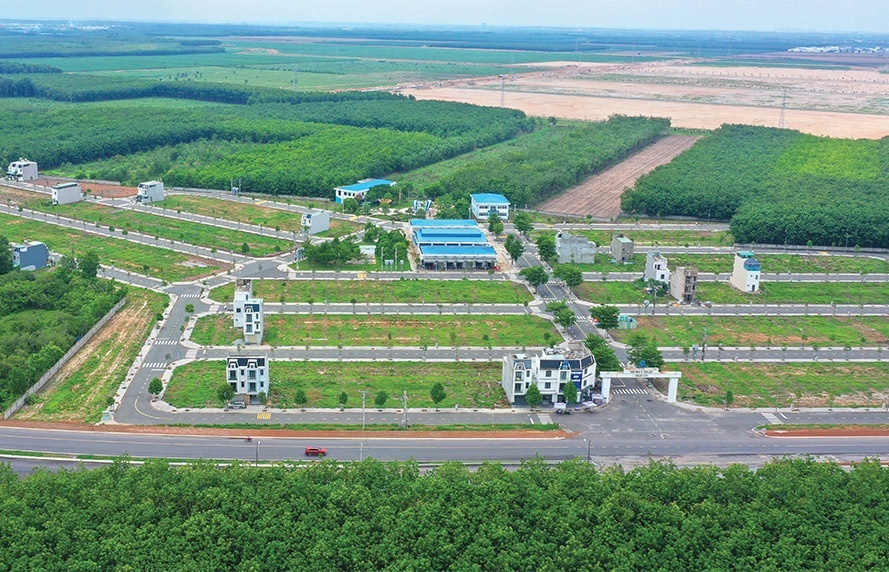Rebuilding property’s credit pipeline
Lending for property projects or mortgage financing is a popular service for international banks. Credit lines for the property sector carry certain risks in direct relation to the fluctuation of property prices. However, in developed property markets with adequate liquidity and sustainability, risk levels are lower.
 Skillful operators can still source capital to reach for the sky |
Prices skyrocketed in the cities and in particular Hanoi and Ho Chi Minh City. Office leasing, residential and land leases for property projects skyrocketed. However, from 2008 the market has become unpredictable. In the first two months of 2008, prices in Hanoi and Ho Chi Minh City moved upward by 10-20 per cent. But since March, 2008 prices have decreased sharply.
The number of selling orders remains far higher than successfully matched transactions. So far, prices are down as much as 35-40 per cent in Ho Chi Minh City. Vietnam’s property market is developing in an unsustainable manner. This would have certain negative impacts on property developers and banks involved in lending for property projects.
Over the last few years, the insolvency of property developers such as Epco Minh Phung and Tamexco has pushed banks’ non performing loans ratio. Acting as a managing authority for credit institutions, the State Bank has worked out legal frameworks for a sound banking market in general and mortgage financing activities in particular.
Document No. 1676/NHNN-CSTT dated March 9, 2008 regulated lending for the property sector. Accordingly, credit institutions have to strictly respect the regulations on land use, investment and construction and banking credit. Local banks have to set up concrete policies on mortgage financing activities to control the systematic risks and caps on lending for property projects. Additionally, commercial banks have to closely watch property market moves, especially property prices. In early 2008, the prime minister also requested the State Bank to tighten controls over the banks’ mortgage lending activities.
Currently, most local banks are applying a tight policy toward lending to property projects. By the end of 2007, the State Bank data showed that total bank credits for property projects account just 11.4 per cent of total outstanding loans. However, by May 31, 2008 the ratio has been cut to 10.1 per cent and by the end of June, 2008 the ratio is estimated to stand at 9.96 per cent.
Credit growth for the sector over the first half of 2008 is just 5 per cent, much lower than gross credit growth of more than 18 per cent over the first half of 2008. Bank credits are mostly for property projects in Ho Chi Minh City, accounting for 60 per cent and Hanoi 17 per cent. In the total credit for property business, banks’ loans for individual customers to buy houses make up only 9 per cent, the remainder is for project developers.
Generally credit for the sector has not rung the alarm bells yet to the relevant authorities. The low level of credit for property sector in total outstanding loans means that banks can still bear fluctuations in prices. However, while state-owned commercial banks have a lower ratio (7.8 per cent), joint-stock banks with a higher ratio (around 19 per cent) could be at risk.
Some smaller banks have ratios of up to 30 per cent. Loans for the sector in Vietnam are divided into two categories, with medium and long term loans making up 74 per cent and short-term loans 24 per cent. Long-term loans normally last up to 20-30 years while the longest term of banks’ deposits is just around 10-15 years. Thus, the term-gap could bring certain risks to local lenders.
This coupled with the wide-fluctuation in property prices, the lack of information and not-up-to-standard transparency of enterprises in the property sector make loans for property quite risky. To minimise risks, commercial banks should follow State Bank regulations on property-backed credit services. It will also accelerate supervision and inspections and relevant authorities need to cooperate to improve the legal framework for the sector to ensure a sustainable development of this business.
What the stars mean:
★ Poor ★ ★ Promising ★★★ Good ★★★★ Very good ★★★★★ Exceptional
Related Contents
Latest News
More News
- US election result alters financial market outlook (November 21, 2024 | 11:02)
- Gamuda Land Vietnam named Best Developer at PropertyGuru awards (November 19, 2024 | 16:48)
- GELEX Tower achieves LEED Platinum certification (November 19, 2024 | 09:53)
- Real estate businesses expand interest in available land to thrive in 2025 (November 17, 2024 | 08:47)
- Ho Chi Minh City revamps land status (November 17, 2024 | 08:43)
- Trump's trade policies could shape Vietnam's economic outlook: Dragon Capital (November 15, 2024 | 16:56)
- The One Destination partners with Singapore investor and institutional fund to build ESG real estate complex (November 11, 2024 | 10:32)
- Stabilising measures must sit alongside land price hikes (November 07, 2024 | 09:56)
- CapitaLand Development records strong bookings for Orchard Hill (November 07, 2024 | 08:19)
- Public transport and real estate: The rise of Transit Oriented Development (November 05, 2024 | 15:06)




 Tag:
Tag:




















 Mobile Version
Mobile Version